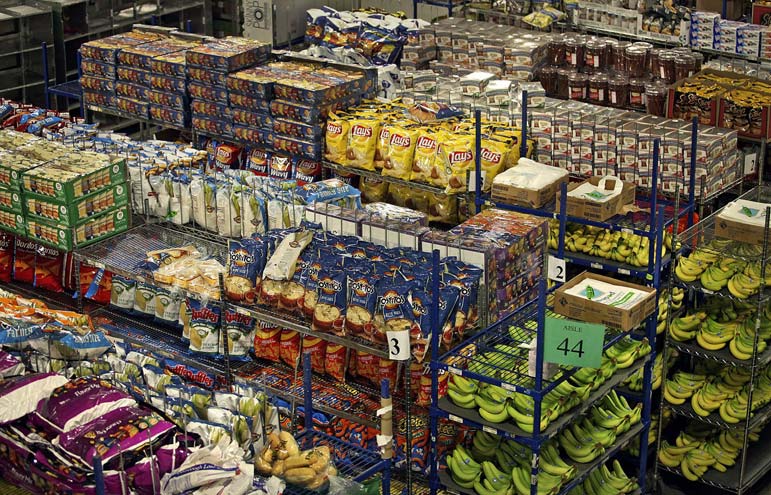
Grocery guru Chrissy Pate knows how to stack coupons, price match and stockpile her way to groceries for as much as 80 percent off - even scoring some products free. She runs the savings website BeCentsAble.net and during the recession held "coupon parties" where she taught others to shop and save as she does.
Yet when her Kansas City-area grocery store started offering online shopping about a month ago, Pate jumped at the chance to try it, even though there was a delivery fee and her store did not allow paper coupons or price matching for online orders. Why would a power shopper be willing to forgo some of her favorite savings strategies to shop online?
"For shoppers who take the time to stack coupons and price match, shopping in-store will bring bigger savings," Pate explained. "But, let's face it, many people are never going to do that and, for them, online shopping is another way to save, because you can keep an eye on your running total as you shop to stick to your budget."
So Pate took the plunge. "Right after I placed my order, I went to the store to test out what the price difference would have been," she said, "and I found everything I ordered was the same price at the store."
Whether grocers mark up prices in their online stores is a big question. I checked prices at Giant and Safeway, two of the largest grocery chains in the country, against those of their own delivery services. The total for 10 popular products at both chains' brick-and-mortar locations came to about $45. Their online store totals were within a dollar or two of that, not counting delivery. Of course, I priced only 10 items, but when the website Cheapism.com compared stores' online and in-store prices it also found that they were pretty consistent.
So if we consider that settled, then it's all about whether you can make back the delivery fee. Stores charge between $7.95 and $12.95 to deliver your groceries, depending on the size of your purchase. You may also want to tip your driver, although some stores don't allow it.
You offset a little of that money right away because you do not have to pay for gas, but the bigger benefit is the time saved by skipping the trip. Shopping online saves time in other ways, too. First, even on your very first online shopping trip, if you enter your loyalty card number, all the products you've bought at the store in the past should pop up as a customized shopping list. Just click the ones you'd like to buy again and you're done. No inefficient wandering from aisle to aisle. Second, shopping from home also means you can check your pantry to see whether you need something, rather than guessing and wasting food. Third, taking kids to the supermarket inevitably takes more time. Delivery solves that. "You can shop in your PJs after the kids are in bed," Pate points out.
But by far the best way to earn back your delivery fee is by using the online store's running cost tally as you shop. "A lot of people like that ability to manage their budget and take things out of their cart if they need to," said Peg Merzbacher of Giant's Peapod delivery service. And you can do it without making a scene in the checkout line.
The computer's knack for sorting also can help you shop around. "We make it easy to sort your selections by unit price," Merzbacher said. "That's a little cumbersome to do in-store, looking up and down the shelves, but it's easy to do online."
Personally, when I have time, I enjoy going to the grocery store to see what's new and what's in season. I think of this as "inspiration" for my cooking. Others would call it by another I-word: "impulse buying." Shopping online short-circuits those unplanned purchases. "For us, it's kind of challenging, because we may be losing some of the impulse buys," Merzbacher said.
Bottom line for your bottom line: If you're a super shopper with the time and discipline to stack coupons, price match and shop in-person, that's how you will save more money. But if you're more of a frazzled shopper, you could well do better by shopping online, sidestepping impulse buys and watching that running total so you stay on budget.
More tips for grocery savings
Online:
• Some stores allow you to use paper coupons for online orders by presenting them to your driver. Others have virtual coupons right on their websites.
• Look for tools that list products you have purchased in the past that are currently on sale.
• Some grocers have coupon codes for free delivery or offer free delivery for orders over a certain dollar amount. Manufacturers will sometimes pay for your delivery if you buy a certain amount of their products.
• When certain delivery time slots are not filling up, stores often discount them.
In-store:
• As I compared in-store and online prices, I saw several in-store deals that were not available online. Keep an eye out.
• Advanced couponers know that you can usually "stack" manufacturer and store coupons.
• To save the most, try stocking up on nonperishables when they are at their cheapest, rather than when you need them.
• Scan all the store circulars in your area, then cherry-pick the best deals all at one store that price matches. This usually works in-store only.
Leamy is a 13-time Emmy winner and 25-year consumer advocate for programs such as "Good Morning America" and "The Dr. Oz Show."


 Contact The Editor
Contact The Editor
 Articles By This Author
Articles By This Author
